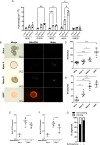Druggable redox pathways against Mycobacterium abscessus in cystic fibrosis patient-derived airway organoids
- PMID: 37619220
- PMCID: PMC10449475
- DOI: 10.1371/journal.ppat.1011559
Druggable redox pathways against Mycobacterium abscessus in cystic fibrosis patient-derived airway organoids
Abstract
Mycobacterium abscessus (Mabs) drives life-shortening mortality in cystic fibrosis (CF) patients, primarily because of its resistance to chemotherapeutic agents. To date, our knowledge on the host and bacterial determinants driving Mabs pathology in CF patient lung remains rudimentary. Here, we used human airway organoids (AOs) microinjected with smooth (S) or rough (R-)Mabs to evaluate bacteria fitness, host responses to infection, and new treatment efficacy. We show that S Mabs formed biofilm, and R Mabs formed cord serpentines and displayed a higher virulence. While Mabs infection triggers enhanced oxidative stress, pharmacological activation of antioxidant pathways resulted in better control of Mabs growth and reduced virulence. Genetic and pharmacological inhibition of the CFTR is associated with better growth and higher virulence of S and R Mabs. Finally, pharmacological activation of antioxidant pathways inhibited Mabs growth, at least in part through the quinone oxidoreductase NQO1, and improved efficacy in combination with cefoxitin, a first line antibiotic. In conclusion, we have established AOs as a suitable human system to decipher mechanisms of CF-driven respiratory infection by Mabs and propose boosting of the NRF2-NQO1 axis as a potential host-directed strategy to improve Mabs infection control.
Copyright: © 2023 Leon-Icaza et al. This is an open access article distributed under the terms of the Creative Commons Attribution License, which permits unrestricted use, distribution, and reproduction in any medium, provided the original author and source are credited.
Conflict of interest statement
Julien Mazières reports grants or contracts from Astra Zeneca, Roche and Pierre Fabre; and payment or honoraria for board and expertise (personal and institution) from Merck, Astra Zeneca, BMS, MSD, Roche, Novartis, Daiichi, and Pfizer; outside the submitted work. Hans Clevers reports invention on patents related to organoid research. His full disclosure: www.uu.nl/staff/JCClevers/Additional function. The other authors have declared no competing interests.
Figures





References
-
- Floto RA, Olivier KN, Saiman L, Daley CL, Herrmann JL, Nick JA, et al.. US Cystic Fibrosis Foundation and European Cystic Fibrosis Society consensus recommendations for the management of non-tuberculous mycobacteria in individuals with cystic fibrosis. Thorax. 2016;71 Suppl 1: i1–i22. doi: 10.1136/thoraxjnl-2015-207360 - DOI - PMC - PubMed
Publication types
MeSH terms
Substances
LinkOut - more resources
Full Text Sources
Medical
Miscellaneous

